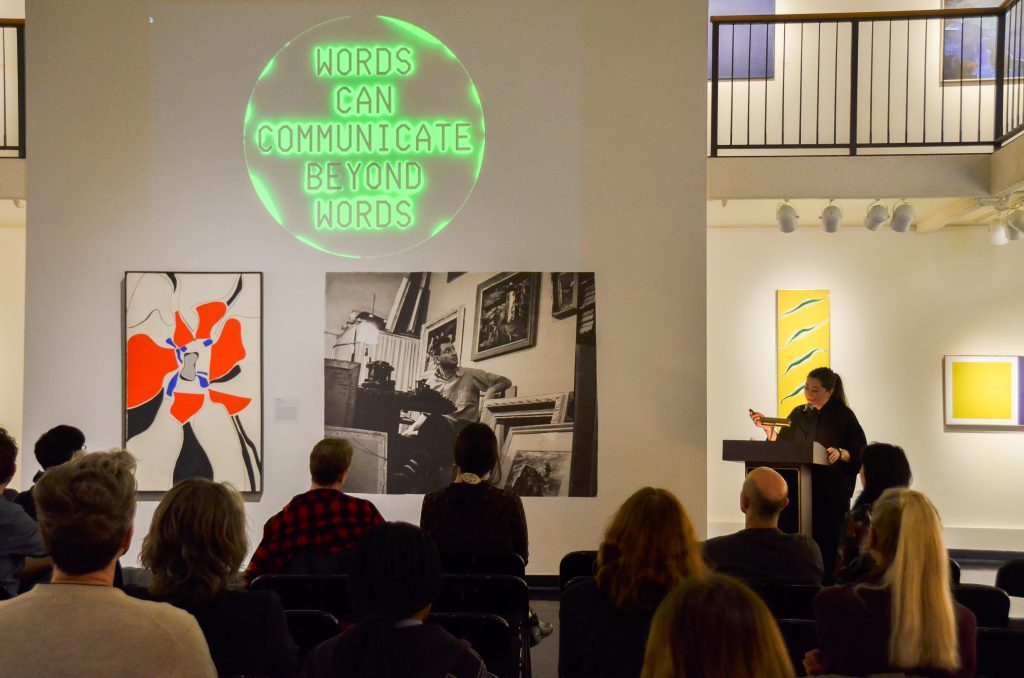Sasha Stiles, a poet, language artist and artificial intelligence (AI) researcher, read and discussed her work involving AI at the first of three events this week in the Binghamton University Art Museum (BUAM).
Students, faculty and BU community members attended the event on Wednesday night, which was sponsored by the Visuals and Material Worlds Transdisciplinary Areas of Excellence Seed Grant, filling the main gallery of BUAM. The night included a presentation of how Stiles has created works that encompass both analog and digital methods of artistic expression in our modern world.
Stiles, who lives in the New York City area, began the event by talking about how her interest in pushing the limits of conventional poetry led her to become interested in the potentials of AI technology.
“As I was doing research into experimental poetics and computational poetics and generative poetics, I started to learn about an area of [AI] called natural language processing,” Stiles said. “I immediately became intrigued by the idea of what this kind of [AI] that could write language humans, what that could mean for creativity, what it could mean for authorship and also what it could mean for my craft and my technique.”
Later on, she shared some of her work, which included a poem from her new book “Technelegy” that was generated by AI from the prompt she wrote. “Completion: When It’s Just You,” began with Stiles’ question, “When it’s just you / will you be lonely? / How lonely? / Just how lonely / will you be?” A portion of the 100-line poem was presented as a “poetic film,” which Stiles spoke about as an extension of her practice of integrating technology into poetics.
“For me, one of the joys of my practice is being able to take the text of a poem and to see how it can sprout new forms — how it can take new shapes and sort of become new experiences across different mediums, how it can metamorphosize in different directions using technology as a canvas and as a page,” Stiles said.
A short discussion and Q&A period followed the unconventional poetry reading, where Stiles and the event organizer, Director of Creative Writing Tina Chang, delved deeper into her work. As Stiles’ former poetry teacher, their conversation was marked by their casualness as they discussed Stiles’ first encounters with AI in 2018 and 2019, how the digital nature of some of her work allows for greater mobility and transmission, her use of the blockchain, NFT’s, the metaverse and much more.
Chang discussed how they met each other and how Chang’s interest in Stiles’ work began.
“When she studied with me both in classroom settings and independently, she wrote in analog, and I was intrigued by her voice,” Chang wrote in an email. “In recent years she has become invested in the intersections of art and technology, and began to integrate digital tools and artificial intelligence into her work. With the rise of [ChatGPT] and discussions about AI at universities nationwide and globally, I saw this as an opportunity to have a conversation at the University campus with a poet who is utilizing AI tools to welcome varied perspectives.”
With how fast AI has advanced and adapted in recent years and ChatGPT being released to the public in November of 2022, Stiles has consistently been on the forefront of its use, especially in creative spaces. While she acknowledges that AI art can be basic and surface-level in its meaning, she hopes that, as a tool of collaboration, artists and the public will begin to engage with the technology on its own terms.
“Unlike when I started, there are now a plethora of wonderful, powerful platforms and interfaces that enable almost anyone to experiment with creative AI,” Stiles wrote in an email.
Stiles went on to mention sudowrite.com, a tool created by her friends, and ChatGPT as particularly useful tools for creative writers and art enthusiasts, respectively.
The event had an impact on Luciana Carvo, a senior majoring in English, leading her to question the distinct categories that she had placed poetry and technology into.
“I just never really thought about artificial intelligence and how to use it in poetry,” Carvo said. “I thought that they were technology and poetry, two separate things. I also thought we should be inspired simply by our mind and not influenced by technology and I think I’m now rethinking that entirely and am glad that I am.”
This change of thinking is central to understanding the ambitions and works of Stiles, whose ethos can be distilled into a few of her words on Wednesday night that “poetry is technology, our most ancient and enduring data storage system.”
Following this principle, Stiles has been able to utilize AI to preserve her Kalmyk heritage. By training and mentoring her personal AI and co-author about her family’s heritage, languages and traditions, she has been able to replicate her memories and experiences and harness them with AI.
“My mother is Kalmyk-Mongolian, and she speaks a dialect called Kalmyk that is not very well known and that’s very endangered,” Stiles said. “A lot of the stories, the rituals that I remember from my childhood are not practiced anymore, but they’re still very deeply embedded in who I am, and I’d like to … keep them going forward. So I’ve been experimenting with using [AI] for translation and voice coding and things like that to try and create systems that can help me decipher and preserve some of these family stories, some of these very personal kind of moments, these sounds and these languages.”
Stiles’ work in “Technelegy” and the digital aspects of her presentation give new meaning to the word “memory,” connoting both the human and the mechanic, both nerve endings and binary code. With the ability to create a replicable repository of family history, perhaps the meaning of the word will no longer seem so contradictory.



